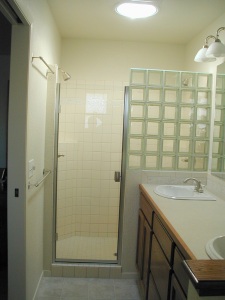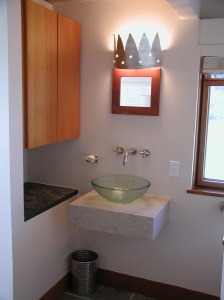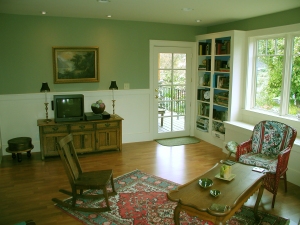While Rose Construction generally does all the painting for our projects, every once in a while we get a client who would rather paint him- or herself to keep costs down. Painting, though it initially seems easy, requires a lot of prep work in order to get a professional looking finish. After all, who wants streaks and blotches all over their living room wall? If you’re considering doing your own painting, I’ve included a few tips.
The key to a good paint job is prep work. It can take a lot of time, but the results speak for themselves. According to Easy2DIY, you should remove all plates from your walls, such as electrical switch plates and phone jack covers. If you have a hanging light fixture, you should also remove the cover so that you can paint under it. You should protect the fixture itself (as well as any radiators or anything else you don’t want painted) by covering with plastic or a canvas drop cloth. Then you should wash the walls from the bottom up with a good household cleaner. However, you don’t want the cleaner to mix with your paint, so don’t forget to rinse afterward. Finally, fill in all holes and repair cracks, as paint does not cover them (I certainly discovered that not long ago!).
Now, on to the paint. House Painting Info lists a wonderful tip about determining existing paint types:
An important interior painting preparation step for your ceilings and walls is identifying the type of ouse paint originally used on the walls, ceiling and painted woodwork.
To do this, use a clean white cloth, painters rag, and denatured alcohol. Apply the alcohol to the cloth and gently rub the surface. If any paint is softened or removed then the finish is an acrylic or latex paint. If no color is on the rag and the finish is still unaffected then it is an oil base.
Acrylic, latex, house paints cannot be applied over Alkyd, oil base, finishes without being primed first. However, an Alkyd, oil base, house paint can be applied over an Acrylic, latex finish.
I could describe the best method for painting but often people learn better watching somebody else. If you need to work on your roller technique, don’t understand what feathering is or if you want to know if you’re painting your walls correctly, please watch this Expert Village video. The master painter in the video, Grady Johnson, has a number of other videos you can view in his How to Paint a House series, including how to cut in, sand trim and paint door jambs.
One thing that you will never see a professional painter using is a roller pan. If you would like to learn to use a bucket screen, Tom Cornett writes about the method as well as provides a step by step instructional video for cutting, the way to paint next to trim without using tape. Tape is another item you will hardly ever see in the hands of a professional painter, so cutting is an essential skill.
Of course, you may be wondering about paint itself. Pat has said time and time again, NEVER use contractor’s grade paint. It is simply a poor product no matter what manufacturer produced it. Beyond that, the standard amongst interior designers seems to be Benjamin Moore. But of course, to each his own. From what I’ve heard, Sherwin Williams also makes a great paint and my personal favorite is Rodda. Then again, I am not a professional painter so please take that with a grain of salt. With paint you often get what you pay for, so I would suggest staying away from the least expensive paints you can find. They are typically very low quality.
There are a number of more eco- and health-friendly paints in the market. If you are considering Low VOC paints, please read this article about what you should be looking for. VOC is the abbreviation for Volatile Organic Compound, which often carries chemicals and preservatives such as formaldehyde, benzene, lead, cadmium, chromium, diethyl phthalate and dibutyl. These compounds can cause asthma attacks, headaches and even cancer or kidney disease for the chronically exposed.
Some of the healthiest paints you can find are natural or non-toxic. Companies who produce these paints include: Bio Shield (less toxic, less allergenic paints, stains, thinners and pigments), Livos (wood treatment products made from raw plant materials), Auro (solvent-free paints, stains, oils and waxes) and the Old Fashioned Milk Paint Company (organic, bio-degradable and VOC-free paint that uses milk protein as a binder). We have never used any of these products but they seem like wonderful ideas.
Finally, please remember to dispose of your paint properly! If you’re using a latex based paint, please do not contaminate the storm drain, groundwater or septic by washing your paint brushes in the sink or with outside with a hose. These brushes should be cleaned with solvent in a container. You can reuse the solvent and eventually discard it at Bellingham’s Disposal of Toxics Facility. If your paint can is empty and you are throwing it out, remember to remove the lid. It is a good idea to throw some kitty litter or sawdust in the paint so there is no dripping that would result in contamination.
If this isn’t enough information about paint and painting for you, check out the Professional Painting Contractors Forum where all other questions can be answered.
© Rose Construction 2009




